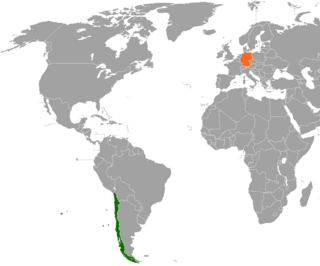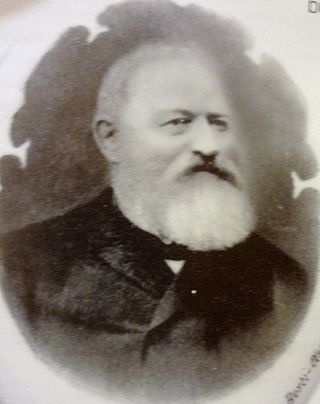
Eduardo Alfredo Juan Bernardo Frei Ruiz–Tagle is a Chilean politician and civil engineer who served as president of Chile from 1994 to 2000. He was also a Senator, fulfilling the role of President of the Senate from 2006 to 2008. He attempted a comeback as the candidate of the ruling Concertación coalition for the 2009 presidential election, but was narrowly defeated. His father was Eduardo Frei Montalva, president of Chile from 1964 to 1970.

The Araucanía, La Araucanía Region is one of Chile's 16 first-order administrative divisions, and comprises two provinces: Malleco in the north and Cautín in the south. Its capital and largest city is Temuco; other important cities include Angol and Villarrica.
Nueva Helvecia is a city in Colonia Department of Uruguay.

The Occupation of Araucanía or Pacification of Araucanía (1861–1883) was a series of military campaigns, agreements and penetrations by the Chilean army and settlers into Mapuche territory which led to the incorporation of Araucanía into Chilean national territory. Pacification of Araucanía was the expression used by the Chilean authorities for this process. The conflict was concurrent with Argentine campaigns against the Mapuche (1878–1885) and Chile's wars with Spain (1865–1866) and with Peru and Bolivia (1879–1883).
German Chileans are Chileans descended from German immigrants, about 30,000 of whom arrived in Chile between 1846 and 1914. Most of these were from Bavaria, Baden and the Rhineland, and also from Bohemia in present-day Czech Republic, which were traditionally Catholic. A smaller number of Lutherans immigrated to Chile following the failed revolutions of 1848.
Immigration to Chile has contributed to the demographics and the history of this South American nation. Chile is a country whose inhabitants are mainly of Iberian, mostly of Andalusian and Basque origin, and Native American, mostly descended from Mapuche peoples. A moderate numbers of European immigrants settled in Chile during the 19th and 20th centuries, mainly Spanish, as well as Germans, British, French, Southern Slavs, and Italians who have made additional contributions to the racial complex of Chile. However, this immigration was never in a large scale, contrasting with mass migrations that characterized Argentina, Uruguay and southern Brazil, and therefore, anthropologically, its impact with lesser consequence. At the same time, some separate cultural aspects, such as German cakes, British afternoon tea, and Italian pasta, were preserved. The fusion is also visible in the architecture of Chilean cities. This intermarriage and mixture of cultures and races have shaped the present society and culture of Chile.

The Swiss diaspora refers to Swiss people living abroad, also referred to as "fifth Switzerland", alluding to the fourfold linguistic division within the country. The Federal Department of Foreign Affairs (FDFA) cares for Swiss people living abroad.
British Chileans are Chilean residents with fully or partial antecedents from the United Kingdom. The British have been very important in the formation of the Chilean nation. They include Chileans of English, Scottish, Ulster Scots, (Northern) Irish and Welsh ancestry. The numbers of Scottish and Welsh are higher in Patagonia, in Aysén and Magallanes regions. The highest percentage of British Chileans is found in Punta Arenas, followed by Santiago, Valparaíso, Concepcion, Viña del Mar and Antofagasta.
English Chileans are citizens of Chile who are descended from English emigrants. They are estimated to number 550,000-820,000.

Victoria is a city and commune in Malleco Province of La Araucanía Region, Chile. It is the second most populous city in the Malleco Province, and is the gateway to the area known as Araucanía Andina, with attractions such as the Tolhuaca National Park, the Tolhuaca Hot Springs, Malalcahuello National Reserve, and the communes of Curacautín and Lonquimay. The climate is influenced by the vicinity of the temperate rainforest in Chile.

Capitán Pastene is a town founded by Italian immigrants, located in the commune of Lumaco in the Araucanía Region of Chile.
Gastón Gori (1915–2004) was an Argentine essayist and poet.
From 1850 to 1875, some 30,000 German immigrants settled in the region around Valdivia, Osorno and Llanquihue in Southern Chile as part of a state-led colonization scheme. Some of these immigrants had left Europe in the aftermath of the German revolutions of 1848–49. They brought skills and assets as artisans, farmers and merchants to Chile, contributing to the nascent country's economic and industrial development.

Gregorio Urrutia Venegas was a Chilean military official who made a career in the Chilean Army, reaching the rank of brigadier general. He held several military positions and participated in four military conflicts. He was also a deputy and businessman of a company that built railway lines.
The last major rebellion of the indigenous Mapuches of Araucanía took place in 1881, during the last phase of the Occupation of Araucanía (1861–1883) by the Chilean state. It was planned by Mapuche chiefs in March 1881 to be launched in November the same year. Mapuche support for the uprising was not unanimous: Some Mapuche factions sided with the Chileans and others declared themselves neutral. The organizers of the uprising did however succeed in involving Mapuche factions that had not previously been at war with Chile. With most of the attacks repelled within a matters of days Chile went on the next years to consolidate its conquests.

German-Chilean relations are foreign relations between Germany and Chile. Around 12,300 kilometers separate Chile and Germany but both nations still share a wide range of bilateral relations. Over the course of the last 150 years many Germans have settled in Chile for several different reasons. Migrating in the opposite direction, several thousand Chileans sought refuge in Germany during Pinochet's dictatorship.
A Swiss Guatemalan is a Guatemalan of Swiss heritage, hailing from the waves of immigration that began in the 19th century. The Swiss often came simultaneously with expatriates from Belgium and Germany during the first period of immigration in the 1840s, with many arriving as chartered settlers.

Santiago Otto Schaerer Kuenzli was a Swiss emigrant, trader, settler and important colonizer in South America. He was the founder and administrator of several Swiss colonies, most prominently Nueva Helvecia in Uruguay and San Bernardino in Paraguay. He was the father of the 25th president of Paraguay Eduardo Schaerer and grandfather of businessman and journalist Arturo Schaerer.

Agriculture in Chile has a long history dating back to the Pre-Hispanic period. Indigenous peoples practised varying types of agriculture, from the oases of the Atacama Desert to as far south as the Guaitecas Archipelago. Potato was the staple food in the populous Mapuche lands. Llama and chilihueque herding was practised by various indigenous groups.
[Chile] is rich in pastures and cultivated fields, in which all kind of animals and plants can be breed or grown, there is plenty of very beautiful wood for making houses, and plenty of firewood, and rich gold mines, and all land is full of them...
Giorgio Ricci was an Italian entrepreneur known for bringing Italian immigrants to Araucanía in Chile under fraudulent conditions. Araucanía had been recently incorporated to Chile (1861-1883) when Ricci in 1904 brought to Chile a group of Italian immigrants from Emilia-Romagna, promising good lands for agriculture. Once in Chile immigrants were disappointed by the fact the lands he granted them were hilly forest not suitable for agriculture. The colony was initially called Nueva Italia but changed in 1907 name to Capitán Pastene. Soon however, many left for nearby towns such as Temuco and Traiguén or even farther away into Santiago. In 1906 Ricci repeated the scheme bringing Italian immigrants in Brazil to Nueva Etruria west of Gorbea. As with Capitán Pastene immigrants were lured into lands not particularly suitable for agriculture. By 1908 very few Italians remained in Nueva Etruria. Ricci was rewarded by the Chilean state with lands for helping colonizing the country.










